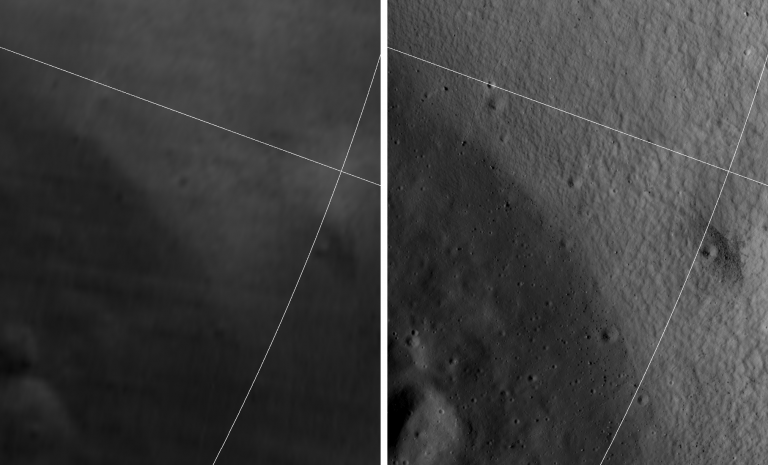Science
Related: About this forumNew Spacecraft Can See Into the Permanently Shadowed Craters on the Moon

Images of the permanently shadowed wall and floor of Shackleton Crater captured by Lunar Reconnaissance Orbiter Camera (LROC) (left) and ShadowCam (right). Each panel shows an area that is 5,906 feet (1,800 meters) wide and 7,218 feet (2,200 meters) tall. Image Credit: NASA/KARI/ASU.
FEBRUARY 11, 2023 BY NANCY ATKINSON
Shackleton Crater at the lunar south pole is one of the locations on NASA’s shortlist for human exploration with the future Artemis missions. But because craters at the lunar poles — like Shackleton — at have areas that are perpetually in shadow, known as permanently shadowed regions (PSRs), we don’t know for sure what lies inside the interior. However, a new spacecraft with a specialized instrument is about to change all that.
ShadowCam is one of six science instruments on board the Korea Aerospace Research Institute (KARI)’s Korea Pathfinder Lunar Orbiter, known as Danuri, which launched in August 2022 and entered lunar orbit last December. ShadowCam’s mission is to peer inside these dark craters and determine for sure what lies within, and if the PSRs contain volatiles like water ice – a significant resource for exploration that can be used as fuel or oxygen.
“ShadowCam has the potential to greatly increase our understanding of the quality and abundance of those resources in these regions,” said Jason Crusan, Director of NASA’s Advanced Exploration Systems Division, in press release from 2017, announcing ShadowCam. “Future missions in deep space will be safer and more affordable if we have the capability to harvest lunar resources.”
The ShadowCam instrument has been in an operational checkout period since the spacecraft entered lunar orbit. During the checkout, it has been collecting dozens of images of the lunar polar regions, including an image of Shackleton Crater, to calibrate and test its functionality.
More:
https://www.universetoday.com/160038/new-spacecraft-can-see-into-the-permanently-shadowed-craters-on-the-moon/
Judi Lynn
(161,925 posts)Author Vanessa Lloyd
Posted on February 9, 2023 4:37 pm
With the success of NASA’s Artemis I launch, the previously unexplored shadowy regions near the lunar South Pole where Artemis astronauts will land in 2025, are more within our reach than ever before.
One instrument that will support these future lunar exploration efforts is a hypersensitive optical camera called ShadowCam. ShadowCam is one of six instruments on board the Korea Aerospace Research Institute (KARI)’s Korea Pathfinder Lunar Orbiter, known as Danuri, which launched in August 2022 and entered lunar orbit last December.
Previous cameras in lunar orbit were designed to acquire images of sunlit surfaces. Developed by Malin Space Science Systems and Arizona State University, ShadowCam’s primary function is to collect images within permanently shadowed regions near the lunar poles. These areas never receive direct sunlight and are thought to contain water ice – a significant resource for exploration that can be used as fuel or oxygen and for other habitation applications.
Building on cameras developed for NASA’s Lunar Reconnaissance Orbiter, ShadowCam is 200 times more light-sensitive and is therefore able to capture detailed images within permanently shadowed regions – even in the absence of direct light – by using the light that is reflected off nearby geologic features such as mountains or the walls of craters.

Images of the permanently shadowed wall and floor of Shackleton Crater captured by Lunar Reconnaissance Orbiter Camera (LROC) (left) and ShadowCam (right). Each panel shows an area that is 5,906 feet (1,800 meters) wide and 7,218 feet (2,200 meters) tall. Image Credit: NASA/KARI/ASU
More:
https://blogs.nasa.gov/artemis/2023/02/09/nasas-shadowcam-images-permanently-shadowed-regions-from-lunar-orbit/